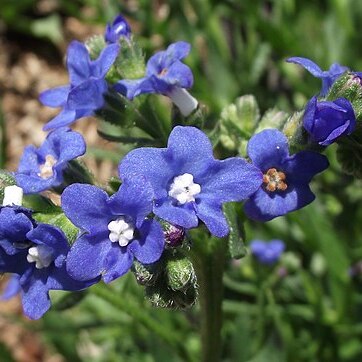A herb. It has tall stems with grooves along them. It grows 60 cm tall. The leaves are bright green. They are narrow and long and rough and hairy to touch. The flowering stems are 1 m tall. The flowers are a vivid blue. They are on the top half of the stems. They have 5 bright blue petals. The seeds are inside small green cups.
Annual or perennial herb, 0.3-0.6 m high, shortly and softly hairy. Calyx deeply 5-Iobed. Corolla tube slightly longer than limb. Flowers blue; October to January and in April.
Softly or roughly hairy annual to 1 m. Leaves oblanceolate. Flowers in helicoid cymes lengthening in fruit, blue or dark blue. Nutlets ovoid, rugose with marginal wing.
Softly or roughly hairy annual, up to 1 m tall. Leaves narrowly ovate. Flowers in helicoid cymes lengthening in fruit, blue or dark blue. Nutlets ovoid.

